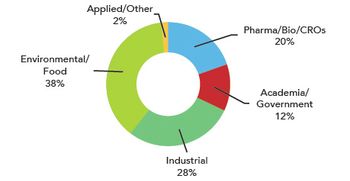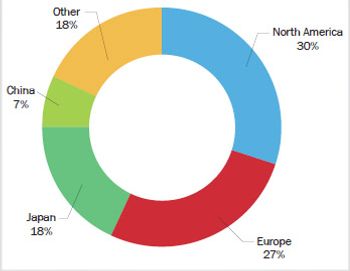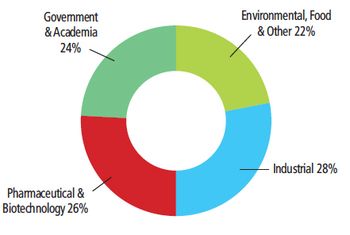
- Spectroscopy-05-01-2007
- Volume 22
- Issue 5
Market Profile: Electron Transfer Dissociation (ETD)
Electron transfer dissociation, generally referred to as ETD, is a new fragmentation technique that is associated with ion trap LC–MS instrumentation. Despite being widely introduced less than two years ago, demand for the technique is increasing rapidly.
Electron transfer dissociation, generally referred to as ETD, is a new fragmentation technique that is associated with ion trap LC–MS instrumentation. Despite being widely introduced less than two years ago, demand for the technique is increasing rapidly.
2006 Worldwide ion trap LC/MS market ($208 million)
ETD is very similar in performance to electron capture dissociation (ECD) in that both fragmentation methods fragment parent ions in a fundamentally different way from all other widely used fragmentation methods, such as collision induced dissociation (CID). The result is that ETD (and ECD) preserves post-translational modifications (PTMs), such as phosphorylations, which other methods do not. Because ECD is not compatible with the RF fields associated with quadrupole and ion trap mass analyzers, a similar method, ETD, was developed for ion trap mass spectrometers.
Although first commercially introduced on ion trap LC–MS systems in 2005, the worldwide market for ETD grew to more than $30 million in 2006, including initial systems, ETD upgrades to previously installed systems, and related aftermarket and service. SDi estimates that nearly a quarter of the ion trap LC–MS market in 2007 will be related to ETD enabled systems. This subsegment of the ion trap LC–MS market is expected to see well over 20% annual growth over the next several years.
The foregoing data were extracted from SDi's market analysis and perspectives report entitled Global Assessment Report, 9th Edition: The Laboratory Life Science and Analytical Instrument Industry, September 2006. For more information, contact Stuart Press, Senior Consultant, Strategic Directions International, Inc., 6242 Westchester Parkway, Suite 100, Los Angeles, CA 90045, (310) 641-4982, fax: (310) 641-8851,
Articles in this issue
over 18 years ago
Pittcon 2007: New Products and Technologiesover 18 years ago
Corrections to Analysis of Noise: Part Iover 18 years ago
Basic Fundamental Parameters in X-Ray Fluorescenceover 18 years ago
Product ResourcesNewsletter
Get essential updates on the latest spectroscopy technologies, regulatory standards, and best practices—subscribe today to Spectroscopy.




